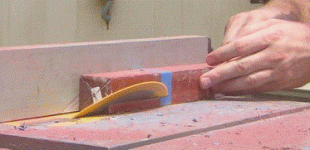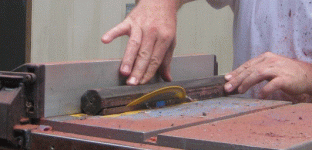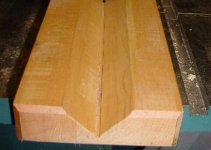When I see photos like these I'm reminded of how lucky I am, having pushed my luck a time or two when I didn't know any better. If this post helps one person work smarter then it was worth it.
These photos are representative of what not to do when working with a table saw.
Notice how in the second picture there isn't enough square surface left to safely keep the wood flat against the table and the fence.
Here are a few safety tips:
1- The area between the two miter slots on the saw is the "danger zone." Keep your body to the left or right of that zone to avoid being impaled by a kickback.
2- Use a push stick on rip cuts less than 6" in width.
3- The blade should only extend about 1/2 tooth out of the wood on a through cut.
4- The safety guard or riving knife help prevent kickbacks.
All that said, there's a better tool for this job- the bandsaw. If that isn't an option, I think a router table with feather boards would be safer.
Failing that, a table saw sled with a V-groove cut into it for the workpiece to ride in would be safer than this.
Again, this is an example of what not to do. Please work as safe as possible, friends. If any of you have any other tips to share, please do.
Google "table saw safety" or "Table saw accidents' for more info. The search can and should be customized for any power tool that you may not be familiar with.
These photos are representative of what not to do when working with a table saw.
Notice how in the second picture there isn't enough square surface left to safely keep the wood flat against the table and the fence.
Here are a few safety tips:
1- The area between the two miter slots on the saw is the "danger zone." Keep your body to the left or right of that zone to avoid being impaled by a kickback.
2- Use a push stick on rip cuts less than 6" in width.
3- The blade should only extend about 1/2 tooth out of the wood on a through cut.
4- The safety guard or riving knife help prevent kickbacks.
All that said, there's a better tool for this job- the bandsaw. If that isn't an option, I think a router table with feather boards would be safer.
Failing that, a table saw sled with a V-groove cut into it for the workpiece to ride in would be safer than this.
Again, this is an example of what not to do. Please work as safe as possible, friends. If any of you have any other tips to share, please do.
Google "table saw safety" or "Table saw accidents' for more info. The search can and should be customized for any power tool that you may not be familiar with.
Attachments
Last edited:




